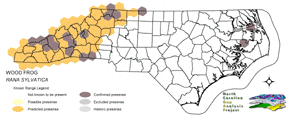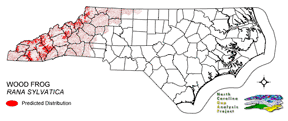
| Taxa: |
| Order: |
| Family: |
| Amphibia |
| Anura |
| Ranidae |
| NatureServe Global Rank: |
| NatureServe State (NC) Rank: |
| G5 |
| S5 |
| Federal Status: |
| NC State Status: |
| --- |
| --- |


| Land Unit |
| US Fish & Wildlife Service |
| US Forest Service |
| US National Park Service |
| US Department of Defense |
| NC State Parks |
| NC University System |
| NC Wildlife Res. Com. |
| NC Forest Service |
| NC Div. of Coastal Mgmt. |
| Local Governments |
| Non-Governmental Org. |
| Other Public Lands |
| Private Lands |
| GAP Status 1-2 |
| All Protected Lands |
| Statewide |
| Hectares |
| 9.81 |
| 171,274.05 |
| 130.68 |
| 61,120.17 |
| 3,132.18 |
| 98.64 |
| 4,325.04 |
| 872.37 |
| 0.00 |
| 4,496.67 |
| 4,138.83 |
| 8.55 |
| 503,874.18 |
| 90,107.55 |
| 249,375.87 |
| 753,481.17 |
| Acres |
| 24.24 |
| 423,227.31 |
| 322.92 |
| 151,031.20 |
| 7,739.78 |
| 243.74 |
| 10,687.40 |
| 3,073.27 |
| 0.00 |
| 11,111.51 |
| 10,227.27 |
| 21.13 |
| 1,245,099.97 |
| 223,578.16 |
| 617,138.68 |
| 1,862,809.76 |
| % of Dist. on |
| Prot. Lands |
| < 0.1 % |
| 68.7 % |
| < 0.1 % |
| 24.5 % |
| 1.3 % |
| < 0.1 % |
| 1.7 % |
| 0.3 % |
| 0.0 % |
| 1.6 % |
| 1.6 % |
| < 0.1 % |
| < 0.1 % |
| 36.1 % |
| ----- |
| ----- |
| % of Dist. on |
| All Lands |
| < 0.1 % |
| 22.7 % |
| < 0.1 % |
| 8.1 % |
| 0.4 % |
| < 0.1 % |
| 0.6 % |
| 0.1 % |
| 0.0 % |
| 0.6 % |
| 0.5 % |
| < 0.1 % |
| 66.9 % |
| 12.0 % |
| ----- |
| ----- |
|
In the southern Appalachian region, it is usually found near upland woodland streams and flooded or boggy depressions. Breeding occurs in shallow ponds or pools. After the breeding period, individuals typically disperse to moist woods or wooded ravines, and can often be found far from surface water (Martof et al. 1980, Wilson 1995, Conant and Collins
1998). NATURE SERVE GLOBAL HABITAT COMMENTS: Various kinds of forest/woodland habitats; edges of ponds and streams; also willow thickets and grass/willow/aspen associations. When inactive, hides in logs, humus, leaf litter, or under logs and rocks. Usually eggs are laid and larvae develop in small fish-free ponds, temporary or permanent, in wooded (usually) or open areas. In the Shenandoah Mountains, breeding adults were 100% faithful to the ponds in which they first bred; approximately 18% of the juveniles dispersed to breed in ponds other than the one of origin (Berven and Grudzien 1991). Experiments and field observations by Hopey and Petranka (1994) indicate that adults are able to assess the presence of fishes in ponds and may change breeding sites accordingly to avoid those with predatory fishes. In northern Minnesota, successful reproduction in acidic bog water either does not occur or is a rare event (Karns 1992). |
| Code | Name | Description | NC Natural Heritage Program Equivalent |
| 238 | Piedmont/Mountain Submerged Aquatic Vegetation | Seasonally to permanently flooded areas with aquatic vegetation. Waterlily, pondweed, hydrilla smartweed are a few of the species that can occur. | Piedmont/Mountain Semipermanent Impoundment (in part) |
| 239 | Piedmont/Mountain Emergent Vegetation | Emergent vegetation of all wetland hydrologies. Sites would commonly support species such as tussock sedge, rushs, and cattail alliances. | Rocky Bar and Shore (in part) |
| 267 | Riverbank Shrublands | Riverside shrubs with temporarily flooded hydrologies. Found in the both the Mountains and Piedmont. Containing dominants such as smooth alder and a Carolina or black willows. | Sand and Mud Bar |
| 269 | Floodplain Wet Shrublands | Saturated shrublands of the Piedmont, includes buttonbush, swamp-loosestrife, decodon and alders. | Piedmont/mountain Semipermanent Impoundment |
| 230 | Piedmont Mesic Forest | American Beech - Red Oak - White Oak Forests. | Mesic Mixed Hardwood |
| 384 | Piedmont/Mountain Mixed Bottomland Hardwood Forests | Includes temporarily to seasonally forests dominated by hardwood species. Hardwoods include sweetgum, red maple, sycamore which co-occur in a mosaic of bottomland and levee positions. Includes alluvial hardwood forests in the mountains. Hemlock and white pine may occur as inclusions, but are generally mapped separately. | Piedmont/Mountain Alluvial Forest, Piedmont/Mountain Levee Forest |
| 383 | Piedmont Mixed Successional Forest | Generally loblolly mixed with successional hardwoods. Sweetgum, tulip poplar and red maple are common co-dominants in these successional forests. | No equivalent |
| 36 | Successional Deciduous Forests | Regenerating deciduous trees with a shrub stature. Commonly dominated by sweetgum, tulip poplars and maples. | No equivalent |
| 8 | Open water | Open water without aquatic vegetation. | No equivalent |
| 517 | Hemlock Floodplain Forest | Alluvial forest with hemlock and/or white pine in mountains and western piedmont. Hydrology is generally temporarily to seasonally flooded. | Canada Hemlock Forest |
| 522 | Northern Hardwoods | High Elevation forests including yellow birch, American beech, and yellow buckeye. Includes forests with Hemlock and Yellow Birch. | Northern Hardwoods Forest, Boulderfield Forest |
| 525 | Appalachian Oak Forest | A variety of oak forest types including Black, White, Scarlet Oaks in dry to mesic situations. Includes forests historically co-dominated by American Chestnut. | High Elevation Red Oak Forest, Montane White Oak Forest |
| 526 | Appalachian Cove Forest | Mixed Mesophytic forests of the mountains. Includes tuliptree, basswood, yellow buckeye and surgar maple. This class is mapped to include cove forests dominated or co-dominated by hemlock. | Rich Cove Forest, Acidic Cove Forest |
| 527 | Appalachian Hemlock | Upland hemlock forests of the moutains region. Vary from side slopes to steep slope positions. | Canada Hemlock Forest |
| 533 | Appalachian Swamp Forest | Evergreen and deciduous forests with saturated hydrologies. This class may contain a variety of trees species, including hemlock - red maple, pitch pine, and white pine forests. | Swamp Forest-Bog Complex, Southern Appalachian Bog, Southern Appalachian Fen |
| 534 | Appalachian Wet Shrubland/ Herbaceous | Saturated shrubs and herbaceous vegetation. Often mapped as an inclusion in Appalachian Swamp Forest. | Southern Appalachian Bog, Southern Appalachian Fen |
|
Bagdonas, K.R. and D. Pettus. 1976. Genetic compatibility in wood frogs. J. Herpetol. 10:105-112.
Berven, K. A., and T. A. Grudzien. 1991. Dispersal in the wood frog (RANA SYLVATICA):implications for genetic population structure. Evolution 44:2047-2056. Zeyl, C. 1993. Allozyme variation and divergence among populations of RANA SYLVATICA. J. Herpetol. 27:233-236. Karns, D. R. 1992. Effects of acidic bog habitats on amphibian reproduction in a northern Minnesota peatland. J. Herpetol. 26:401-412. Hopey, M. E., and J. W. Petranka. 1994. Restriction of wood frogs to fish-free habitats:how important is adult choice? Copeia 1994:1023-1025. Sadinski, W. J., and W. A. Dunson. 1992. A multilevel study of effects of low pH on amphibians of temporary ponds. J. Herpetol. 26:413-422. Wilson, L. A. 1995. The Land Manager's Guide to the amphibians and reptiles of the South. Chapel Hill, NC: The Nature Conservancy. Martof, B.S. and R.L. Humphries. 1959. Geographic variation in the wood frog, Rana sylvatica. Amer. Midl. Nat. 61(2):350-389. Heatwole, H. 1961. Habitat selection and activity of the wood frog, Rana sylvatica Le Conte. Amer. Midl. Nat. 66(2):301-313. Barbour, R. W. 1971. Amphibians and reptiles of Kentucky. Univ. Press of Kentucky, Lexington. x + 334 pp. Minton, S. A., Jr. 1972. Amphibians and reptiles of Indiana. Indiana Academy Science Monographs 3. v + 346 pp. Smith, H. M. 1978. A guide to field identification Amphibians of North America. Golden Press, New York. Martof, B. S., W. M. Palmer, J. R. Bailey, and J. R. Harrison, III. 1980. Amphibians and reptiles of the Carolinas and Virginia. University of North Carolina Press, Chapel Hill, North Carolina. 264 pp. Vogt, R. G. 1981. Natural history of amphibians and reptiles of Wisconsin. Milwaukee Public Museum. 205 pp. Hammerson, G. A. 1982. Amphibians and reptiles in Colorado. Colorado Division of Wildlife, Denver. vii + 131 pp. DeGraaf, R. M., and D. D. Rudis. 1983. Amphibians and reptiles of New England. Habitats and natural history. Univ. Massachusetts Press. vii + 83 pp. Stebbins, R. C. 1985. A Field Guide to Western Reptiles and Amphibians. Second Edition. Houghton Mifflin Company, Boston, Massachusetts. xiv + 336 pp. Green, N. B., and T. K. Pauley. 1987. Amphibians and reptiles in West Virginia. University of Pittsburg Press, Pittsburg, Pennsylvania. xi + 241 pp. Porter, K.R. 1969. Description of RANA MASLINI, a new species of wood frog. Herpetologica 25:212-215. Guttman, D., J. E. Bramble, and O. J. Sexton. 1991. Observations on the breeding immigration of wood frogs Rana sylvatica reintroduced in east-central Missouri. Am. Midl. Nat. 125:269-274. Collins, J. T. 1990. Standard common and current scientific names for North American amphibians and reptiles. SSAR Herpetol. Circular No. 19. 41 pp. Martof, B. S. 1970. Rana sylvatica. Cat. Am. Amph. Rep. 86.1-86.4. Berven, K. A. 1988. Factors affecting variation in reproductive traits within a population of wood frogs (RANA SYLVATICA). Copeia 1988:605-615. Corn, P. S., and F. A. Vertucci. 1992. Descriptive risk assessment of the effects of acidic deposition on Rocky Mountain amphibians. J. Herpetol. 26:361-369. Riha, V. F., and K. A. Berven. 1991. An analysis of latitudinal variation in the larval development of the wood frog (RANA SYLVATICA). Copeia 1991:209-221. |
For more information please contact them at:
NC-GAP Analysis Project
Dept. of Zoology, NCSU
Campus Box 7617
Raleigh, NC 27695-7617
(919) 513-2853
www.basic.ncsu.edu/ncgap